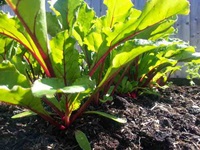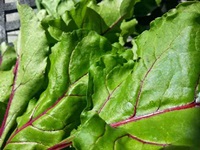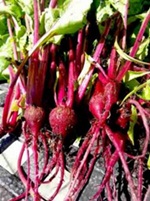![]()
If you’re new to growing vegetables this year you might have noticed that your veg have grown quickly over the past few weeks thanks to some rain, glorious sunshine and a lovely long stretch in the days. They may be growing so fast in fact that they’re falling over themselves reaching for light and space. If this is the case you will have to start ‘thinning’ your seedlings (if you haven’t done so already), which effectively means pulling some of the plants out of the soil to allow space for the others to grow.

Beetroot Plants Waiting to be Thinned
I personally found this a very difficult process when we began growing our own food here at home. I didn’t want to have to make the decision over which plant would be pulled out and which allowed to grow on, after all I had been carefully minding all my seedlings up until that point. All I can say is that the decision-making process gets easier with time as you will quickly see the benefits of giving your vegetables the space to develop properly.

Baby beetroot leaves ~ delicious lightly steamed or sautéed in butter & garlic
Once thinned the vegetables will have the space to grow, they’ll have better access to soil nutrients and they’ll stand a better chance of withstanding diseases thanks to the increase in air circulation between them.
Depending upon which vegetables you’re about to thin, you can tackle the process in a couple of ways:

Baby Beetroot ‘Thinnings’
A) Remove the very small and weak seedlings which will allow the larger, stronger ones to grow on.
B) Remove the large seedlings (or baby vegetables by this stage) and eat them, giving the smaller seedlings space to grow.
I’ve found A) most effective with carrot and parsnip seedlings and B) better with cabbage, swede, beetroot and chard. That said, if the carrots are more than a fingernail length (any smaller and they’re too fiddly to bother with) they are delicious washed and added to salads.
Some seedlings can be pulled and replanted elsewhere – lettuce, cabbage, kale, spinach and chard respond will do this. However, root vegetables don’t generally like being disturbed so it’s usually not worth trying to replant beetroot, carrots and parsnips. That said, there are always exceptions, so if sending your seedlings off to the compost heap is a problem, try replanting them and see what happens. Learning by doing is the best way to remember. (Note: never compost carrot thinnings as they can attract the carrot root fly.)
If you’d like to find out more about thinning vegetables, Gardeners World have some fact sheets for plants that you might find helpful.
Was it just me or have you ever had to get over the dilemma about selecting which seedlings stay and which go?

Dee Sewell – a horticulturalist and certified trainer who started Greenside Up in 2009 and teaches people how to grow vegetables. Dee specialises in working with community gardens but also offers workshops, allotment visits, consultations, horticultural therapy, afterschools clubs as well as local talks – she tailors her services to meet clients needs. In 2012 Dee launched a Seed Gift Collection containing varieties of vegetable and insect friendly flowers with the aim of getting more people growing. Dee’s blog was a finalist in the 2012 Ireland Blog Awards in the Eco/Green and Lifestyle Categories.
Source: GreensideUp – Thinning Vegetables ~ Now’s the Time – Dee Sewell





